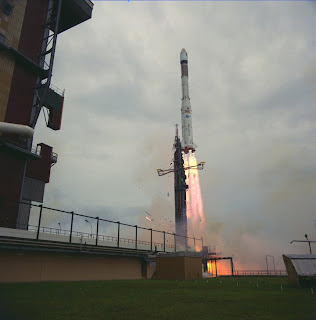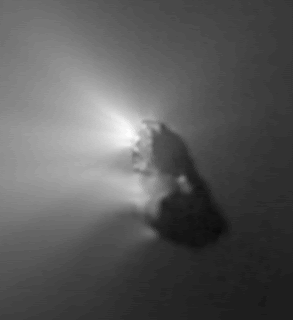

 On the overcast morning of July 2, 1985, the eleventh Ariane 1 rocket launch took place at the Centre Spatial Guyanais in Kourou, French Guiana, an outpost of the European Community located a few degrees north of the equator on the northeast coast of South America (top image above). The last Ariane 1 to fly, it bore aloft Giotto, the first European Space Agency (ESA) interplanetary spacecraft (middle image above). Giotto's destination was Comet Halley.
On the overcast morning of July 2, 1985, the eleventh Ariane 1 rocket launch took place at the Centre Spatial Guyanais in Kourou, French Guiana, an outpost of the European Community located a few degrees north of the equator on the northeast coast of South America (top image above). The last Ariane 1 to fly, it bore aloft Giotto, the first European Space Agency (ESA) interplanetary spacecraft (middle image above). Giotto's destination was Comet Halley.A "dirty snowball" containing materials left over from the birth of the Solar System 4.6 billion years ago, Halley needs about 76 years to revolve around the Sun once. Its elongated orbit takes it as near to the Sun as the space between the orbits of Venus and Mercury and as far from the Sun as the cold emptiness beyond the orbit of Uranus.
Comet Halley has passed through the inner Solar System 42 times since its first recorded apparition. In 837, it passed just 5.1 million kilometers from Earth; during that apparition, its dust tail must have spanned nearly half the sky, and its bright coma - the roughly spherical dust and gas cloud surrounding its icy nucleus - may have been as large as the full moon. During its apparition of 1301, Italian artist Giotto di Bondone painted Comet Halley. The Giotto spacecraft was named for him.
The Ariane 1's third stage injected 980-kilogram Giotto into a 198.5-by-36,000-kilometer orbit about the Earth. Thirty-two hours after launch, as it completed its third orbit, flight controllers in Darmstadt in the Federal Republic of Germany commanded Giotto to ignite its French-built Mage solid-propellant rocket motor. The aft-pointing motor burned 374 kilograms of propellant in 55 seconds to inject the spinning 2.85-meter-tall, 1.85-meter-diameter spacecraft into orbit about the Sun.
Two months before Giotto's launch, Americans P. Tsou (Jet Propulsion Laboratory), D. Brownlee (University of Washington), and A. Albee (Caltech) proposed in a paper in the Journal of the British Interplanetary Society that a second Giotto mission be dispatched to fly close by one of 13 candidate comets between 1988 and 1994. The spacecraft, which they dubbed Giotto II, might launch on an Ariane 3 or in the payload bay of a Space Shuttle. Giotto II's "free-return" trajectory would take it as close as 80 kilometers from the target comet's nucleus, then would return it to Earth. Near the comet, Giotto II would expose sample collectors to the dusty cometary environment. Near Earth, it would eject a sample-return capsule based on the proven General Electric (GE) Satellite Recovery Vehicle (SRV) design. The capsule would enter Earth's atmosphere to deliver its precious cargo of comet dust to eager scientists.
Tsou, Brownlee, and Albee pointed out that the Mage solid-propellant motor was not required to boost Giotto into interplanetary space; that is, that the Ariane 1 could do the job itself. Giotto was, however, based on a British Aerospace-built Geos magnetospheric satellite design, which included the Mage motor. Re-testing the design without the motor would have cost time and money, so ESA elected to retain it for Giotto. After noting that the GE SRV could fit comfortably in the space reserved for the Mage, they proposed that the reentry capsule replace the motor in Giotto II.
Giotto included a "whipple bumper" on its aft end to protect it from hypervelocity dust impacts. During approach to Comet Halley, the spacecraft would turn the bumper in its direction of flight. The bumper comprised a one-millimeter-thick aluminum shield plate designed to break up, vaporize, and slow impactors, a 25-centimeter empty space, and a 12-millimeter-thick Kevlar sheet to halt the partially vaporized, partially fragmented impactors that penetrated the aluminum shield.
In the case of Comet Halley, dust would impact the bumper at up to 68 kilometers per second. Tsou, Brownlee, and Albee noted that the 13 candidate Giotto II comets were all less dusty and would have lower dust impact velocities than Halley. Because of this, Giotto II would need less shielding than Giotto.
Impacting dust would nonetheless create challenges for Giotto II. Tsou, Brownlee, and Albee devoted much attention in their paper to how the spacecraft might successfully capture dust for return to Earth. One capture system, a variant of the whipple bumper, would use a shield made from ultrapure material to vaporize and slow impacting dust particles. The vapor from the impactor and the impacted part of the bumper would then be captured as it condensed. Scientists would disregard the bumper material when they analyzed the condensate.
Tsou, Brownlee, and Albee then noted that thermal blankets returned from the Earth-orbiting Solar Maximum Mission satellite had shown that intact capture of high-velocity particles was possible. The multilayer Kapton/Mylar blankets collected hundreds of intact meteoroids and human-made orbital debris particles. They described preliminary experiments in which "underdense materials" (polymer foams and fiber felts) were subjected to high-velocity impacts by meteoroid and glass fragments fired from gas guns. The experiments suggested that such materials could indeed capture at least partially intact dust particles.
Giotto flew past the Comet Halley nucleus (top image below) at a distance of 596 kilometers on March 13-14, 1986. The comet's 15-by-eight-kilometer heart was extremely dark, with powerful jets of dust and gas blasting into space.
The intrepid probe suffered damage from dust impacts - for example, one large particle sheered off more than half a kilogram of its structure - but most of its instruments continued to operate. ESA thus decided to steer it toward another comet. On July 2, 1990, five years to the day after its launch, Giotto flew past Earth at a distance of 16,300 kilometers, becoming the first interplanetary spacecraft to receive a gravity-assist boost from its homeworld. The gravity assist put it on course for Comet Grigg-Skjellurup, which it flew past at a distance of 200 kilometers on July 10, 1992. After determining that Giotto had less than seven kilograms of hydrazine propellant left on board, ESA turned it off on July 23, 1992. The inert spacecraft flew past Earth a second time at a distance of 219,000 kilometers on July 1, 1999.
By that time, a comet coma sample return mission was under way with two of the Giotto II proposers playing central roles. In late 1995, Stardust became the fourth mission selected for NASA's Discovery Program. Brownlee was Stardust Principal Investigator and Tsou, Stardust Deputy Principal Investigator, designed the mission's sample capture system. The 380-kilogram Stardust spacecraft (top image below) left Earth on a free-return trajectory on February 7, 1999 and flew past Comet Wild 2 (one of the 13 Giotto II candidates) at a distance of about 200 kilometers on January 2, 2004. Stardust captured dust particles in aerogel, a silica-based material of extremely low density that was not available when Tsou, Brownlee, and Albee proposed Giotto II.
Stardust returned to Earth on January 15, 2006. Its sample capsule streaked through the pre-dawn sky over the U.S. West Coast before parachuting to a landing on a salt pan in Utah (bottom image below). When opened on January 17, 2006 at NASA's Johnson Space Center, Stardust's 132 aerogel capture cells contained thousands of intact dust grains captured from Wild 2. Subsequent analysis indicated that some probably formed close to other stars before the Solar System was born.
"Comet Coma Sample Return via Giotto II," P. Tsou, D. Brownlee, and A. Albee, Journal of the British Interplanetary Society, Volume 38, May 1985, pp. 232-239.


No comments:
Post a Comment